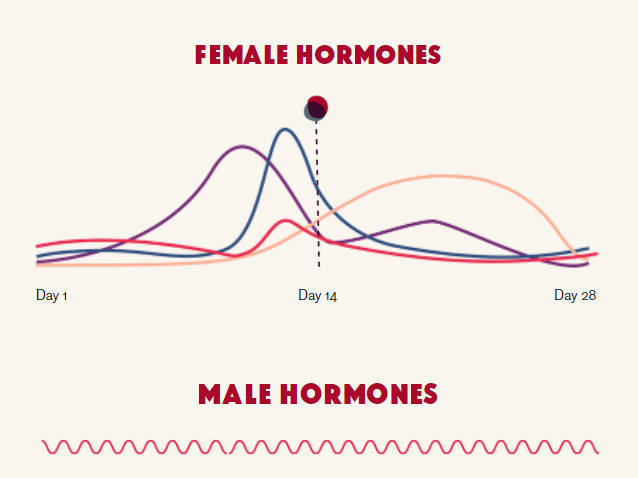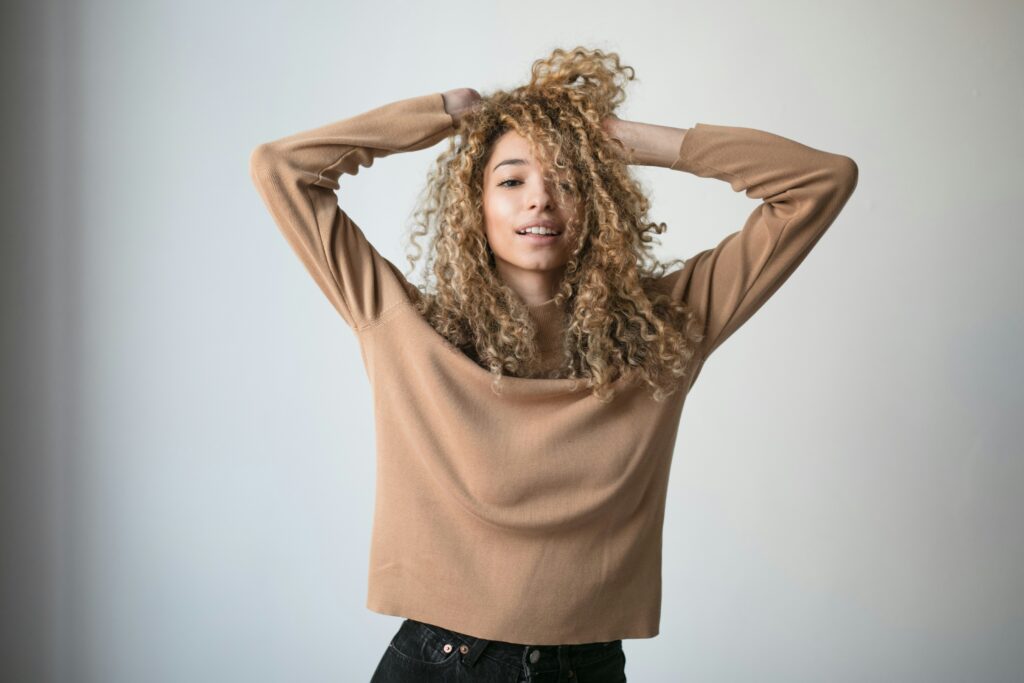Here’s the thing, nature also knows when you are most likely to get pregnant (aka around ovulation) so it makes sense that your libido or levels of sexual desire are heightened around that time in your cycle. That doesn’t mean it’s the only time of the month you can feel desire though. Understanding how your libido changes throughout the menstrual cycle and having cyclical awareness are key.
“Nature intends for you to be pleasured all month long.”
– Alisa Vitti, In the Flo

You can see that while male hormones tend to follow a daily pattern, female hormones (during the reproductive years) follow a longer (monthly-ish) pattern.
So how does the libido change throughout the menstrual cycle?

Libido changes during the Menstrual Phase
This is the low point for your reproductive hormones each cycle. This could mean that your libido dwindles around this time. If that’s you, know that is normal! It’s common to want to retreat and have some quality solo time during your inner winter.
That being said, something interesting happens right before your period. Your uterus increases in volume slightly, so it’s literally a little bit heavier than usual. This extra weight can put pressure on your entire genital structure and it’s not uncommon for this pressure to be pleasurable and put you in the mood for sex!
It’s like your body is giving you an option b when estrogen and testosterone are low.
During menstruation, orgasms have been shown to help relieve menstrual discomfort and stimulating the clitoris releases nitric oxide and oxytocin plus helps flush cortisol. Some people find sex helps them relax the area around the uterus, much like an internal massage.
This is a time to listen to your body, not any culturally created ideas about whether or not pleasure during your period is OK or not.
Things that can help during this phase if you want to engage in intercourse or self pleasure:
- Period/Sex Blankets
- Menstrual Discs
- Lubricant!
Libido changes during the Follicular Phase
At the beginning of the follicular phase (those days between menstruation and ovulation) your hormones are still pretty low. You’re beginning to feel an increase in energy post-menstruation and this is a great phase to plan to do something new or creative with yourself or a partner. Plan a date night to a new museum or attraction, treat yourself to a cooking class, your brain responds well to novelty in the follicular phase. That goes for intimate pursuits as well.
This is still considered a dry phase, especially at the beginning Estrogen has not started to rise much yet. Estrogen is what tells our cervix to produce that naturally lubricant cervical fluid that’s prevalent around when we ovulate. So don’t hesitate to use lubricant during this phase if needed.
Libido changes during the Ovulatory Phase
Like we discussed at the beginning of this article, your libido doesn’t usually need much help during the ovulatory phase. You are naturally primed for desire and to receive pleasure.
This is because leading up to the actual moment of ovulation estrogen and testosterone are surging right now. Estrogen is responsible for telling your cervix to produce that fertile cervical fluid (you know the clear, stretchy, lubricative stuff) that helps sperm stay alive and testosterone plays an important role in sexual desire and gratification.
You are also naturally more social so this is a great time to go to social gatherings, plan group outings etc. It’s also a great time for first dates! If the ovulatory phase was a phase of the moon, it’d be the full moon. This means its a great time for speaking about your dreams, desires, etc. Having conversations like that with a partner is great for strengthening you bond.
Be aware however, the ovulatory phase is also the fertile time in your cycle. If pregnancy is not on your current bingo card, take the precautions you need to be safe.
In the ovulatory phase you are naturally more orgasmic. And research shows the clitoris swells by up to 15-20% at this time due to your hormonal shifts and an increase in blood flow.
Libido changes during the Luteal Phase
The luteal phase is the longest phase of your cycle and can often be broken into two parts.
In the first half, you still have higher levels of estrogen and testosterone. Which usually means you’re more in the mood for sexual activity. Woo hoo!
In the second half, your hormones start to decline as your body prepares for menstruation and this can have an effect on your libido. This is a good time to take things slow. Extended foreplay and lubricant are worth a try.
Sexual desire is achievable at any point in your cycle. Listening to your body (hello Cycle Check-In) and understanding how your libido changes throughout the menstrual cycle will make a big difference.
Don’t forget that The Agenda. app will sync your cycle phases with your Google calendar, so when you’re planning date nights (and those can be solo date nights too) or other life events you can plan accordingly.
*Photo by Thought Catalog on Unsplash
